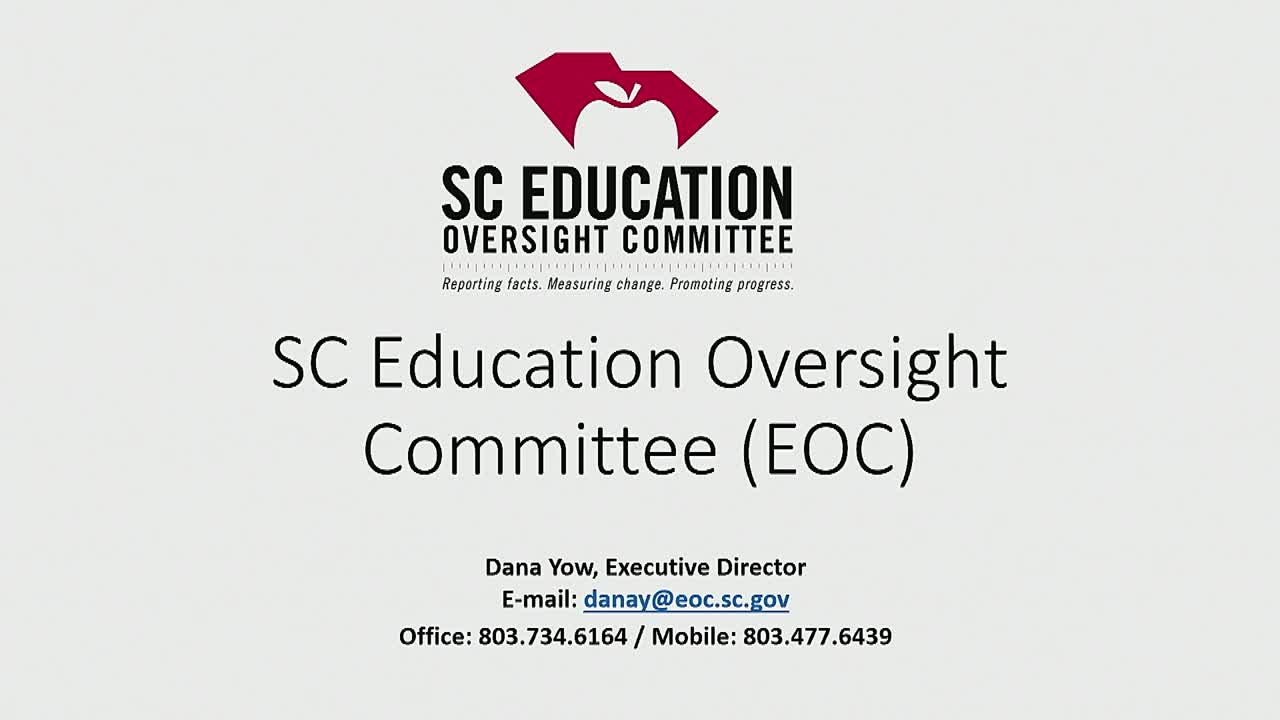Education oversight panel: 85.4% on-time graduation, members alarmed at gaps in college- and career-readiness and chronic absenteeism
May 06, 2025 | 2025 Legislative Meetings, South Carolina
This article was created by AI summarizing key points discussed. AI makes mistakes, so for full details and context, please refer to the video of the full meeting. Please report any errors so we can fix them. Report an error »

At a meeting of the South Carolina House Education and Public Works Committee, Dana Yao, executive director of the Education Oversight Committee, told legislators that the state’s 2024 on‑time high school graduation rate was 85.4 percent and that many graduates do not leave high school with credentials employers or colleges recognize.
The Education Oversight Committee, Yao said, approves statewide content standards and assessments for English language arts, math, science and social studies; issues annual school report cards (legislatively mandated to be issued by Oct. 15); evaluates state‑funded programs and produces public data dashboards (dashboardsc.sc.gov) to help local leaders and lawmakers analyze district and school performance.
Yao highlighted several ongoing EOC projects and findings. The committee’s annual evaluations indicate the state’s full‑day 4K program is producing positive results: “the evaluations that we’ve done show that that program does work for 4‑year‑olds,” she said. The EOC also reviewed a rural teacher recruitment initiative funded with about $7,600,000 in EIA (Education Improvement Act) money and said it plans another evaluation in 2026 to study return on investment for incentives such as housing support, mentoring, international teacher recruitment and recruitment fairs.
The EOC showed a screenshot of its K‑12 dashboard, which Yao said juxtaposes district spending and performance and allows drill‑downs to individual schools. She warned members to examine chronic absenteeism data: the EOC presented figures indicating chronic absenteeism affected a substantial share of students in 2022–23 — students who missed roughly 10 percent of the school year — and that absenteeism depresses academic outcomes.
Committee members pressed for clarity about college‑ and career‑readiness. A member asked if the EOC’s data meant roughly 24 percent of students were both graduating on time and college‑ or career‑ready; in discussion, Yao and other members explained the EOC uses multiple measures (ACT/SAT thresholds, AP/IB and dual‑credit coursework, industry certifications and state career‑readiness assessments) to determine readiness and that results vary by measure and cohort.
The committee discussed retention and remediation strategies, including targeted summer reading camps and the Read to Succeed initiatives the EOC tracks. Yao also said the EOC is conducting parent and student focus groups to understand drivers of absenteeism and is preparing a public awareness campaign to encourage attendance and make students feel “seen” when they return to class.
Members asked for more data. Yao said the slides and dashboard will be shared with committee members and offered follow‑up briefings. No formal votes or policy actions were taken during the presentation; the session was informational and staff were asked to provide additional data and reports.
Ending: The EOC’s small staff (Yao noted the office has about eight FTEs) encouraged members to use the public dashboard and to contact the committee for deeper briefings on accountability reviews, rural recruitment findings and absenteeism focus‑group results.
The Education Oversight Committee, Yao said, approves statewide content standards and assessments for English language arts, math, science and social studies; issues annual school report cards (legislatively mandated to be issued by Oct. 15); evaluates state‑funded programs and produces public data dashboards (dashboardsc.sc.gov) to help local leaders and lawmakers analyze district and school performance.
Yao highlighted several ongoing EOC projects and findings. The committee’s annual evaluations indicate the state’s full‑day 4K program is producing positive results: “the evaluations that we’ve done show that that program does work for 4‑year‑olds,” she said. The EOC also reviewed a rural teacher recruitment initiative funded with about $7,600,000 in EIA (Education Improvement Act) money and said it plans another evaluation in 2026 to study return on investment for incentives such as housing support, mentoring, international teacher recruitment and recruitment fairs.
The EOC showed a screenshot of its K‑12 dashboard, which Yao said juxtaposes district spending and performance and allows drill‑downs to individual schools. She warned members to examine chronic absenteeism data: the EOC presented figures indicating chronic absenteeism affected a substantial share of students in 2022–23 — students who missed roughly 10 percent of the school year — and that absenteeism depresses academic outcomes.
Committee members pressed for clarity about college‑ and career‑readiness. A member asked if the EOC’s data meant roughly 24 percent of students were both graduating on time and college‑ or career‑ready; in discussion, Yao and other members explained the EOC uses multiple measures (ACT/SAT thresholds, AP/IB and dual‑credit coursework, industry certifications and state career‑readiness assessments) to determine readiness and that results vary by measure and cohort.
The committee discussed retention and remediation strategies, including targeted summer reading camps and the Read to Succeed initiatives the EOC tracks. Yao also said the EOC is conducting parent and student focus groups to understand drivers of absenteeism and is preparing a public awareness campaign to encourage attendance and make students feel “seen” when they return to class.
Members asked for more data. Yao said the slides and dashboard will be shared with committee members and offered follow‑up briefings. No formal votes or policy actions were taken during the presentation; the session was informational and staff were asked to provide additional data and reports.
Ending: The EOC’s small staff (Yao noted the office has about eight FTEs) encouraged members to use the public dashboard and to contact the committee for deeper briefings on accountability reviews, rural recruitment findings and absenteeism focus‑group results.
View full meeting
This article is based on a recent meeting—watch the full video and explore the complete transcript for deeper insights into the discussion.
View full meeting